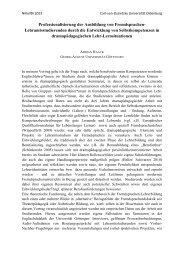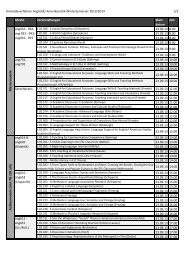1 Guidelines and Style Sheet for Writing Research Papers in Literary ...
1 Guidelines and Style Sheet for Writing Research Papers in Literary ...
1 Guidelines and Style Sheet for Writing Research Papers in Literary ...
Create successful ePaper yourself
Turn your PDF publications into a flip-book with our unique Google optimized e-Paper software.
Once you have looked at the state of research <strong>and</strong> the primary material as it relates to the topic<br />
that <strong>in</strong>terests you, you can <strong>for</strong>mulate a proposition that you will seek to substantiate. Here are<br />
a few typical l<strong>in</strong>es of argument that may help you decide which argument should guide your<br />
structure:<br />
o One typical l<strong>in</strong>e of argument: Scholars have always agreed that this phenomenon should<br />
be described as [x], but I disagree. The reasons [if any] they have given, are the<br />
follow<strong>in</strong>g… The reasons why I disagree are the follow<strong>in</strong>g.<br />
o Another typical l<strong>in</strong>e of argument: Scholars have never been able to agree about whether<br />
we should describe this phenomenon as [a] or as [b]. Those who favour [a] argue that …,<br />
those who favour [b] argue that …, a critical evaluation of their arguments shows that …<br />
[a is right / b is right / both are partly right <strong>and</strong> partly wrong / both are wrong <strong>and</strong> c is<br />
right]…<br />
o A third typical l<strong>in</strong>e of argument: Scholars have never noticed [a]. They have been talk<strong>in</strong>g<br />
about [b] <strong>and</strong> [c], however. In my judgment, the follow<strong>in</strong>g reason(s) may be responsible<br />
<strong>for</strong> the fact that they have done so. I will now try to show why they were right [wrong] to<br />
ignore [a], <strong>for</strong> the follow<strong>in</strong>g reasons…<br />
o …<br />
2. Quotations, References, <strong>and</strong> the Works Cited List<br />
2.1 Quotations <strong>and</strong> References<br />
When work<strong>in</strong>g with primary <strong>and</strong> secondary sources, you can either quote directly from the<br />
respective material or summarize / paraphrase important aspects <strong>in</strong> your own words.<br />
If you quote directly, you have to give the author of the text you refer to <strong>and</strong> the page(s) on<br />
which your quote can be found. If you have two or more works by the same author, also give<br />
an abbreviated <strong>for</strong>m of the title to <strong>in</strong>dicate which particular work you are referr<strong>in</strong>g to. This<br />
<strong>in</strong><strong>for</strong>mation is given <strong>in</strong> round brackets immediately after the respective quotation.<br />
NOTE: When omitt<strong>in</strong>g parts of the orig<strong>in</strong>al text <strong>in</strong> your quotation, use “[…]” to <strong>in</strong>dicate<br />
where someth<strong>in</strong>g has been left out.<br />
Examples:<br />
“…[…]…” (Fenton 45); “…” (Hall “Deconstruct<strong>in</strong>g” 230-31); “…” (Roth Portnoy 25)<br />
If you summarize or paraphrase other peoples’ works, you also have to give the author, a<br />
short title (if necessary) <strong>and</strong> the page number(s). To <strong>in</strong>dicate that you are paraphras<strong>in</strong>g <strong>and</strong> not<br />
quot<strong>in</strong>g directly, add the abbreviation “cf.” (i.e. “confer”).<br />
Examples:<br />
… (cf. Fenton 45); … (cf. Hall “Deconstruct<strong>in</strong>g” 230-31); … (cf. Roth Portnoy 25)<br />
When quot<strong>in</strong>g <strong>and</strong> paraphras<strong>in</strong>g, you can also give the author (as well as the title) <strong>in</strong> your<br />
cont<strong>in</strong>ous text. The page number(s) are then added <strong>in</strong> round brackets after the quotation or<br />
paraphrase.<br />
Examples:<br />
As Fenton argues, … (cf. 45); Accord<strong>in</strong>g to Hall, “…” (“Deconstruct<strong>in</strong>g” 230-31);<br />
As Roth’s protagonist <strong>in</strong> Portnoy states: “…” (25)<br />
7











